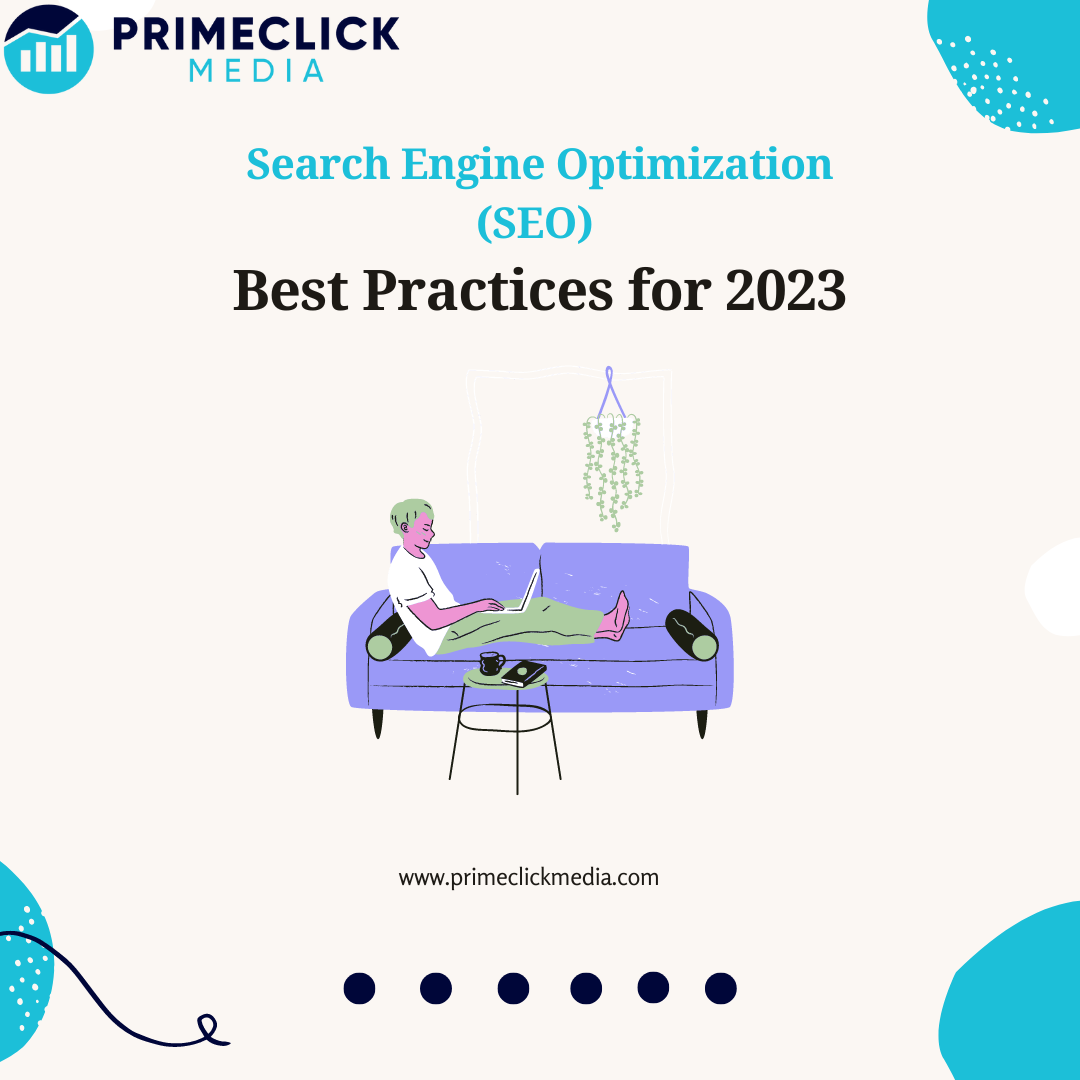Welcome to the world of search engine optimization (SEO), where the rules are ever-evolving and staying ahead of the game is essential for online success. As we step into 2023, it’s time to brush up on the latest SEO best practices that will skyrocket your website’s visibility and drive organic traffic.
In this blog post, we’ll dive into trendy and effective SEO strategies in a simple, easy-to-understand language. Let’s get started on your path to SEO mastery!
The Importance of SEO for Digital Success
Increased Organic Traffic
One of the primary goals of SEO is to improve your website’s organic (non-paid) search engine rankings. When your website appears higher in search results, it attracts more clicks and drives increased organic traffic. Studies have shown that websites on the first page of search results receive the majority of clicks, with higher-ranking positions receiving even more. By optimizing your website, you can capture a larger share of organic traffic and reach your target audience effectively.
Enhanced User Experience
SEO entails making your website’s many components—such as its speed, mobile friendliness, and navigation—better. These optimizations not only please search engines but also enhance the user experience. Users prefer websites that load quickly, are easy to navigate, and provide valuable content. By focusing on SEO best practices, you create a seamless and enjoyable user experience, leading to increased engagement, longer site visits, and higher conversion rates.
Builds Brand Credibility and Trust
When your website ranks higher in search results, it signals to users that search engines consider it relevant and trustworthy. High search engine rankings instill credibility and trust in your brand, as users often associate top-ranking websites with authority and expertise. By consistently appearing in relevant search results, you establish your brand as a reputable source within your industry, building trust with your audience and potential customers.
Cost-Effective Marketing
Compared to other digital marketing channels, SEO offers a cost-effective and sustainable approach to driving organic traffic. While there may be upfront costs involved in optimizing your website, the long-term benefits far outweigh the initial investment. Unlike paid advertising, which requires ongoing budget allocation, SEO efforts can continue to generate organic traffic and deliver results over time. By investing in SEO, you build a solid foundation for continuous organic growth and reduce your reliance on paid marketing efforts.
Stay Ahead of the Competition
In today’s competitive online landscape, businesses that neglect SEO risk being left behind. Your competitors are likely investing in SEO to improve their online presence and capture valuable organic traffic. By embracing SEO best practices, you can stay ahead of the competition, outrank them in search results, and reach your target audience first. SEO allows you to level the playing field and compete with larger businesses, regardless of your size or industry.
Long-Term Sustainability
SEO is a long-term tactic that yields enduring outcomes. While it may take time to see the full impact of your SEO efforts, the benefits can be long-lasting. Unlike temporary marketing campaigns or paid advertisements that disappear once the budget runs out, the effects of SEO can continue to drive organic traffic and generate leads or sales over an extended period.
By consistently optimizing your website and adapting to evolving SEO practices, you can enjoy sustained success in the digital realm.
How Does Google Determine a Page’s Ranking?
Google ranks pages in its search results using a sophisticated algorithm. While the exact details of the algorithm are not publicly disclosed, Google provides some insights into the factors it considers when ranking pages. Here’s a general overview of how Google determines page rankings:
Relevance
Google assesses how closely a page’s content matches the search query. It analyzes the presence of keywords and their placement within the page, including the title, headings, and body text. Pages that provide comprehensive, accurate, and relevant information to the user’s query are more likely to rank higher.
Authority and Quality
Google assesses the authority and quality of a page by considering various factors. Backlinks from other reputable websites are an important indicator of authority. The more high-quality backlinks a page has, the higher its perceived authority. Additionally, Google assesses factors like the page’s content quality, user engagement metrics (such as bounce rate and time on page), and overall user experience to determine its ranking.
User Experience
Google values a positive user experience and factors it into ranking decisions. Pages that load quickly, are mobile-friendly, and have intuitive navigation are more likely to rank higher. Google wants to ensure that users have a seamless and satisfying experience when accessing websites from its search results.
Freshness and Updates
Fresh and updated content often receive preference in search rankings. Google recognizes the importance of providing users with the most current and relevant information. Pages that regularly update their content, publish new articles, or refresh existing information may have an advantage in ranking.
User Intent
Google strives to understand the user’s intent behind a search query and deliver the most relevant results. It analyzes the language used in the query and aims to provide results that match the user’s underlying needs or objectives. Pages that align closely with the user’s intent have a higher chance of ranking well.
It’s important to note that Google’s algorithm is constantly evolving, with frequent updates and refinements. Google aims to improve the search experience and ensure that users find the most relevant and useful information. This means that SEO strategies need to adapt and align with these algorithm updates to maintain or improve page rankings.
SEO Best Practices
User-Centric Content is King
In the realm of SEO, content reigns supreme. But here’s the catch: it must be user-centric. Focus on creating high-quality, engaging content that solves problems, answers questions, and provides value to your target audience. Craft compelling headlines, write in a conversational tone, and include relevant keywords naturally. Remember, search engines prioritize user satisfaction, so prioritize their needs in your content creation.
Mobile Optimization Takes Center Stage
Mobile optimization has been important for a while, but it’s now a non-negotiable SEO practice. With the majority of internet users accessing content on their mobile devices, ensuring your website is mobile-friendly is crucial. Optimize your website’s design, layout, and loading speed for seamless mobile experiences. Don’t forget to prioritize responsive design and user-friendly navigation for smaller screens.
Voice Search Optimization
As voice assistants like Siri, Alexa, and Google Assistant become increasingly popular, optimizing for voice search is a game-changer. People search differently when using voice commands, so adapt your content to include long-tail, conversational keywords, and phrases. Consider creating FAQ pages that address common voice search queries, and optimize your website for local voice search to tap into the growing trend of “near me” searches.
The Need for Speed
In the fast-paced digital world, speed matters. Users expect websites to load lightning-fast, and search engines reward those that deliver. By utilizing caching, image compression, and code minification, you may increase the speed of your website. Use tools like Google PageSpeed Insights to identify and fix performance bottlenecks. Remember, a faster website enhances user experience and boosts your SEO rankings.
Secure Your Website with HTTPS
Website security is no longer optional; it’s a must-have for SEO success. Implementing HTTPS (Hypertext Transfer Protocol Secure) encrypts data transmission between your website and users, ensuring a secure browsing experience. Search engines prioritize secure websites, so obtain an SSL certificate and migrate your website from HTTP to HTTPS. It’s not just about SEO; it’s about building trust with your audience.
Harnessing the Power of Video
Video continues to dominate the digital landscape, and search engines recognize its impact. Incorporating video content into your SEO strategy can yield significant results. Create interesting and educational videos that speak to the interests of your target audience and optimize them with pertinent keywords. Host videos on your website or leverage platforms like YouTube, and don’t forget to provide keyword-rich titles, descriptions, and transcripts for better visibility.
Build Quality Backlinks
Backlinks remain a crucial ranking factor, but quality is more important than quantity. Focus on acquiring backlinks from reputable and relevant websites within your industry. Invest in content outreach, guest blogging, and building relationships with influencers to earn valuable backlinks. Remember, natural, authoritative backlinks are a testament to your website’s credibility and can significantly boost your SEO performance.
How to Measure SEO?
Measuring SEO involves analyzing various metrics and data points to evaluate the effectiveness of your optimization efforts and understand how they impact your website’s performance. Here are some key metrics and methods to measure SEO:
Organic Traffic
Monitoring organic traffic is crucial in assessing the impact of SEO. Tools like Google Analytics provide insights into the number of visitors coming to your website through organic search. By tracking changes in organic traffic over time, you can evaluate the effectiveness of your SEO strategies and campaigns.
Keyword Rankings
Tracking keyword rankings helps you understand how well your website is ranking for specific search terms. Tools like SEMrush, Ahrefs, or Google Search Console allow you to monitor keyword positions and observe fluctuations. By monitoring keyword rankings, you can identify opportunities for improvement and gauge the success of your SEO efforts.
Click-Through Rate (CTR)
CTR gauges the proportion of visitors who click on the link to your website when it pops up in search results. It reflects the appeal and relevance of your title tags and meta descriptions. Analyzing CTR can help you optimize your snippets to increase click-throughs and drive more organic traffic.
Conversion Rate
The conversion rate measures the percentage of visitors who complete a desired action on your website, such as making a purchase, filling out a form, or subscribing to a newsletter. By tracking conversion rates for organic traffic, you can determine the effectiveness of your SEO in driving valuable actions and conversions.
Backlink Profile
Monitoring your backlink profile helps you understand the quality and quantity of links pointing to your website. Tools like Moz or Majestic provide insights into the number of backlinks, their authority, and any potential issues or spammy links. Tracking your backlink profile helps you identify areas for improvement and assess the impact of your link-building efforts.
Page Load Speed
Page load speed is an essential factor in user experience and SEO. Pages that load slowly may have a detrimental effect on user engagement and rankings. Tools like Google PageSpeed Insights or GTmetrix can assess your website’s performance and provide recommendations for improving page load speed.
Bounce Rate and Time on Page
The percentage of visitors to your website that leave after only reading one page is referred to as the “bounce rate.” Time on page measures how long users spend on your website before navigating away. These metrics provide insights into the engagement and relevance of your content. Lower bounce rates and longer time on the page indicate that visitors find your content valuable and engaging.
Social Engagement
Monitoring social media metrics, such as likes, shares, comments, and follower growth, can help you understand the impact of your SEO efforts on social platforms. Social engagement reflects the visibility and shareability of your content, as well as its resonance with your audience.
Conclusion
With these SEO best practices for 2023, you’re equipped to conquer the digital landscape. Prioritize user-centric content, optimize for mobile and voice search, ensure website speed and security, embrace video marketing, and build quality backlinks. Stay on top of the latest trends and algorithm updates, and adapt your strategy accordingly.
By mastering SEO in the year 2023, you’ll elevate your online visibility, drive organic traffic, and propel your website to new heights. Let the SEO journey begin!





